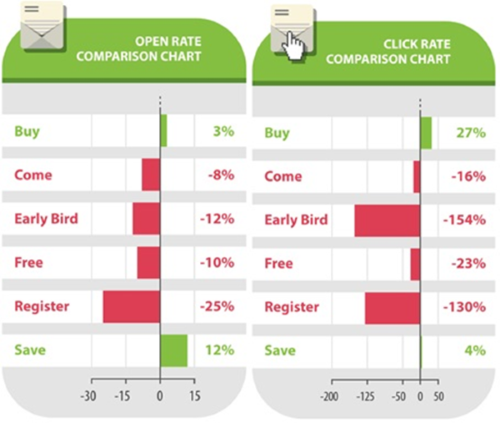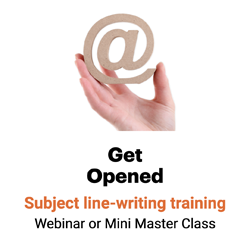Target the recipient to boost email analytics
Useful information is among the top three reasons people share information via email or social media, according to research by Chadwick Martin Bailey:

- Because I find it interesting/entertaining (72%)
- Because I think it will be helpful to recipients (58%)
- To get a laugh (58%)
Those findings echo research by three professors at Carnegie Mellon University. They found that the best way to write subject lines that get opened is to show that your email contains useful information.
In a series of “think-aloud” studies, these professors asked participants to sort through emails in their own inboxes and in inboxes developed for the study.
The answer? Readers are most likely to open emails with subject lines that focus on utility, or relevance — on “information I can use to live my life better.”
So how do you write useful, helpful, relevant subject lines that get opened?
1. Lead with the benefits.
Best subject line ever? This one, from Dawn Grubb, got opened fast:
Margaritas today at 5? I’m buying
Opportunities, offers and discounts drive the most opens, according to Lyris Technologies. So focus on what’s in it for the recipient, not what’s in it for the sender.
This one, a promotional email from Portland Monthly’s Shop Talk, had me at Tim Gunn:
Talk to Tim Gunn | Free Kiehl’s Product | Bad Mall Photos
These two benefits subject lines got opened by subjects in a Nielsen Norman Group test — despite the fact that recipients didn’t know the sender (And overcoming sender unfamiliarity isn’t easy!):
Z100 Pays Your Bills!
Lonely Planet’s top 10 beaches
“When users are looking through their inboxes and dealing with vast amounts of email, any indication that a message with worth opening is helpful,” write Kim Flaherty, et al., in Marketing Email and Newsletter Design to Increase Conversion and Loyalty.
This classic advice for every message you write — no surprise! — also works for subject lines: Write about the readers’ needs, not about us and our stuff.
So think benefits.
Benefits words are verbs, not nouns. And the voice of benefits is the imperative.
We learned in school that the imperative voice was the command voice, and it can be:
Go to your room! Do the dishes! Take out the trash!
But used for benefits writing, the imperative voice becomes the invitation voice:
Save money! Make money! Save time!
No wonder benefits verbs like add, open and try increase email reading, according to a study by Return Path, a global data and marketing firm. Return Path looked at more than 2 million email subscribers from 3,000 retail senders over a month last year.
(So, for that matter, do command verbs, like register, download and click.)
Benefits verbs in subject lines increase email reading, says Return Path |
||
Average read rate for subject lines containing this keyword |
Keyword influence on read rate |
|
Register |
24.19% | +6.70% |
Open |
16.48% | +1.73% |
Add |
16.56% | +1.13% |
Find |
15.16% | +.58% |
Download |
25.03% | +0.3% |
Try |
13.71% | +0.28% |
Click |
12.27% | +0.20% |
Phrasee adds weight to this evidence. Phrasee crunched the numbers on more than 40 billion successful (and not so successful) emails to identify what works and what does not in subject lines.
When it comes to verbs, experiential words like celebrate get top results. Commands like spend perform less effectively. (Because who wants to spend?)
Imperative voice works, says Phrasee |
||||
Phrase |
Phrasee score™ |
Open rate |
Click rate |
CTO rate |
Celebrate |
64 | 6.3% | -18.1% | -22.9% |
Buy |
61 | 18.0% | -16.0% | -28.8% |
Get your |
54 | 10.7% | 43.4% | 29.6% |
| *The Phrasee score is a normalized, weighted score that aggregates the overall effect a phrase has on response. The higher the Phrasee score, the more reliably positive the results are. | ||||
And verbs like continues? Those are lackluster, too, probably because continues is a third-party verb (Wylie Communications continues to be great!)
Readers care more about themselves and their needs that about your company and its stuff. I think continue would have fared better (Continue to become a better writer every day.)
Adestra obtained similar results. Adestra analyzed more than 3 billion emails (free download) to learn which words work — and which don’t — in subject lines.
The U.K.-based email service provider found that verbs like buy and save outperformed adjectives — including free. So consider call-to-action subject lines.

So does this mean that Register! Celebrate! Save! is the best subject line ever?
Not at all.
What it does mean is that leading with a benefits-oriented verb, using the imperative voice and focusing on what the reader will get out of your email is a best practice for subject lines. Just like it is for every other thing you write.
2. Write how-to subject lines.
How-to information is the No. 2 type of content that gets retweeted, according to research by Dan Zarrella (PDF), viral marketing scientist for HubSpot. Tipsheets and service stories — aka “how to” stories — are also more likely to be read, used and acted upon.
No wonder Zarrella’s list of the 17 words that get clicked most often include tips and latest.
So find readers’ pain points and offer ways to address them. Words and phrases like how to and secrets suggest the kinds of value-added service stories that readers seek.
How to words in subject lines increase email reading, according to Return Path |
||
Average read rate for subject lines containing this keyword |
Keyword influence on read rate |
|
Steps |
11.94% | +1.23% |
Ways |
13.65% | +0.17% |
Why |
12.11% | -0.83% |
Here’s how |
12.47% | -1.00% |
And, though Return Path didn’t test it, How to has always been a winner for service stories. Why not test that phrase for your subject lines, as well?
3. Use the magic word.
It’s the most retweeted word in the English language, according to viral marketing scientist Dan Zarrella: You.
You is the most retweeted word in the English language.
— Dan Zarrella, viral marketing scientist
And no wonder. Starting your message with “you” pushes the benefits to the front of the sentence and focuses your message on the reader’s favorite subject.
In fact, we’ve known since 1934 that people love to read about themselves. That’s the year Ralph Tyler and Edgar Dale conducted a study that proved that second-person pronouns — you — increase reading, while first-person pronouns (I, me, we, us) reduce readability.
Now we’re learning this lesson again, this time from Return Path’s study. People are less likely to open and click through emails with first-person pronouns (I, me, our, mine) in the subject lines, according to Return Path. Researchers found that you was the only pronoun that increased email readership.
You in subject lines increase email reading, according to Return Path |
||
Average read rate for subject lines containing this keyword |
Keyword influence on read rate |
|
You |
16.73% | +0.10% |
He |
13.07% | -0.05% |
I |
13.02% | -0.12% |
Me |
13.77% | -0.20% |
Our |
15.29% | -0.26% |
It |
13.62% | -0.48% |
Mine |
8.01% | -1.69% |
It’s about the reader! Folks, that’s 85 years of research telling us to write about the reader and the reader’s needs — in subject lines as well as everything else we write. And still, day after day, year after year, we show up at work, open our laptops, and write — once again — about us and our stuff.
So if you want to reach your reader, write about the reader. Don’t write about your organization and its products, services, programs and ideas — aka “us and our stuff.”
In subject lines, as in so much else in life, better you than we.
4. Ask a question.
When auctioneer Dick Soulis let his list know about an opportunity to help producers of a new TV series, his subject line said:
Do You Have A Piece of History?
National Geographic Channel Wants You
And Angie’s List sent asked this question in a subject line:
How long will your paint job last?
Why questions in subject lines?
When the facts are on your side, asking a question is more effective than making a statement, according to research by Daniel J. Howard and Robert E. Burnkrant at Ohio State University.
That’s because people receive statements passively. But with questions, they actively come up with their own reasons for agreeing.
And researchers at the BI Norwegian Business School in Oslo found that people are more likely to click on question headlines with the word “you” than on declarative statement headlines.
Their advice: Ask intriguing questions that make people think, rather than questions with a simple yes or no answer.
What question could you ask to draw readers into your message?
5. Add a number.
Email Labs ran a split test of these three subject lines. Which do you think was most effective?
- Using Link Click-Through Tracking to Segment Your List
- 3 Tips to Improve Your Newsletter’s ROI
- Build Your List Through “Piggy-Back Marketing”
If you guessed the second, you’re right. “3 Tips” produced both higher open and click-through rates than the other two.
Why? Numerals in display copy sell because they promise quantifiable value. So think 3 Tips, 6 Ways, 7 Steps.
Oddly, odd numbers sell better than even ones. So 7 Steps is better than 10 Tips.
6. Add a sense of urgency.
Subject lines that conveyed a sense of urgency were the top performers in Return Path’s study.
Time sensitivity boosts read rates, says Return Path |
||
Average read rate for subject lines containing this keyword |
Keyword influence on read rate |
|
Still time |
33.73% | +15.54% |
Last chance |
16.71% | +1.053% |
Expiring |
16.60% | +1.63% |
Now |
15.756% | +.24% |
Limited time |
14.93% | +3.05% |
So consider reminding recipients that there’s “still time” to take advantage of an offer.
7. Avoid exclamation points.
The average open rate for subject lines without exclamation points was 18% in one study; those without averages a 17% open rate.
The more exclamation points, the lower the open rate. Subject lines with two exclamation points netted 16.7% opens. Add a third, though, and the rate went down to 16.5%.
Make your subject line work.
Some 35% of email recipients use the subject line to decide whether to open a message, according to a study by DoubleClick.
Which means that this teeny-tiny piece of copy does the heavy lifting when it comes to getting your email opened and read.
To get higher open rates, make the most of your 25 to 40 characters: Show your email list that your email is relevant, valuable and useful to your readers.
Learn more digital marketing tips.
- How to write good email subject lines: These subject line strategies can result in more opened emails.
- How to organize content marketing pieces: Make this your email template.
- How to write a case study: Show what you can do by illustrating what you have done.
- Content-marketing-, social media- and blog-writing tips: Get Clicked, Read, Liked & Shared.
- Think Inside the Inbox: Learn more email marketing tips.
- Reach Readers on the Small Screen: Write to be read on mobile devices.

Leave a Reply